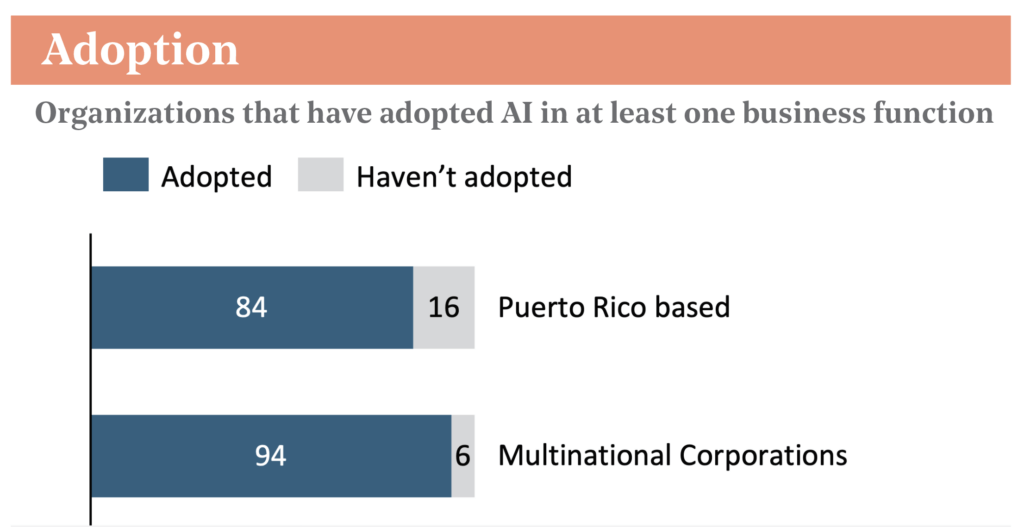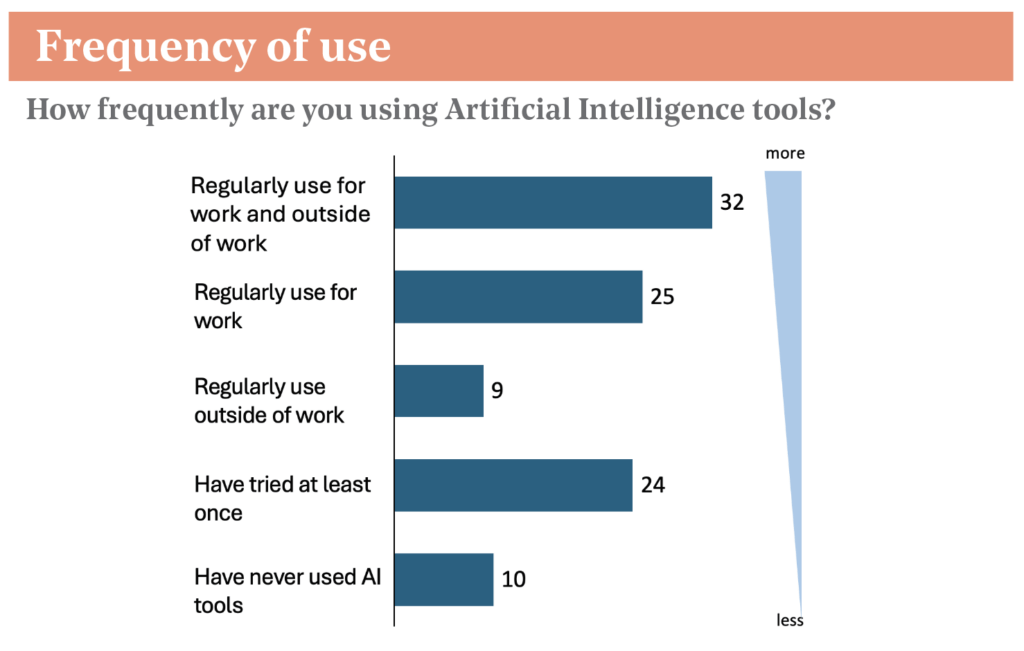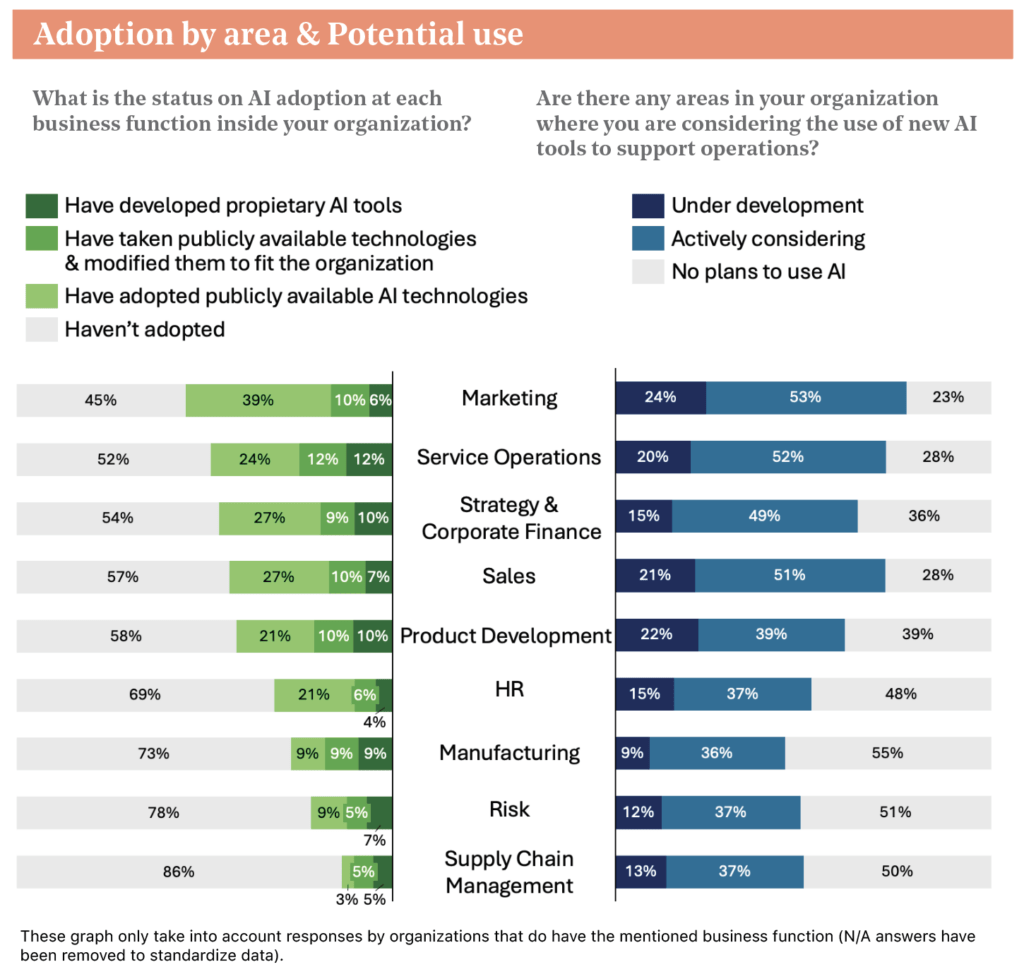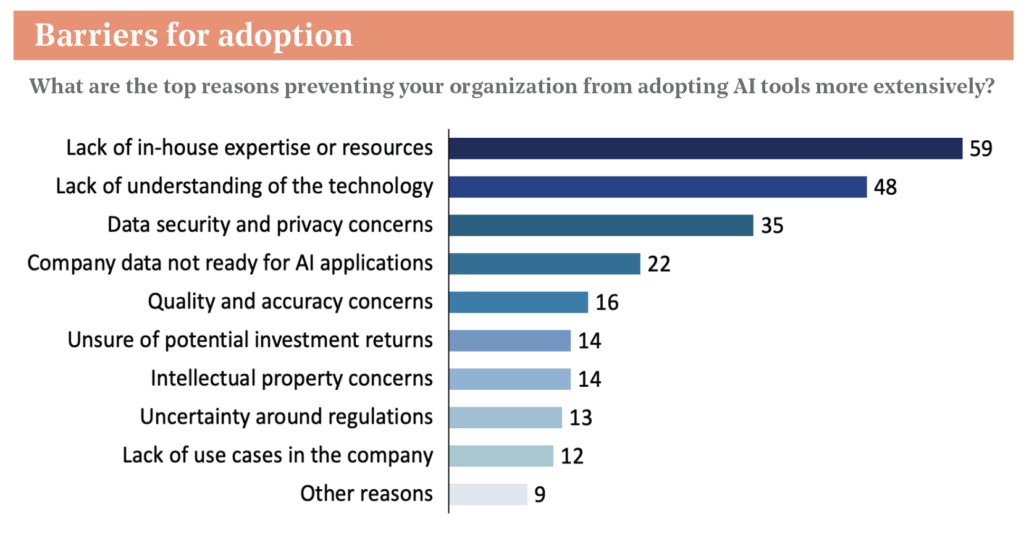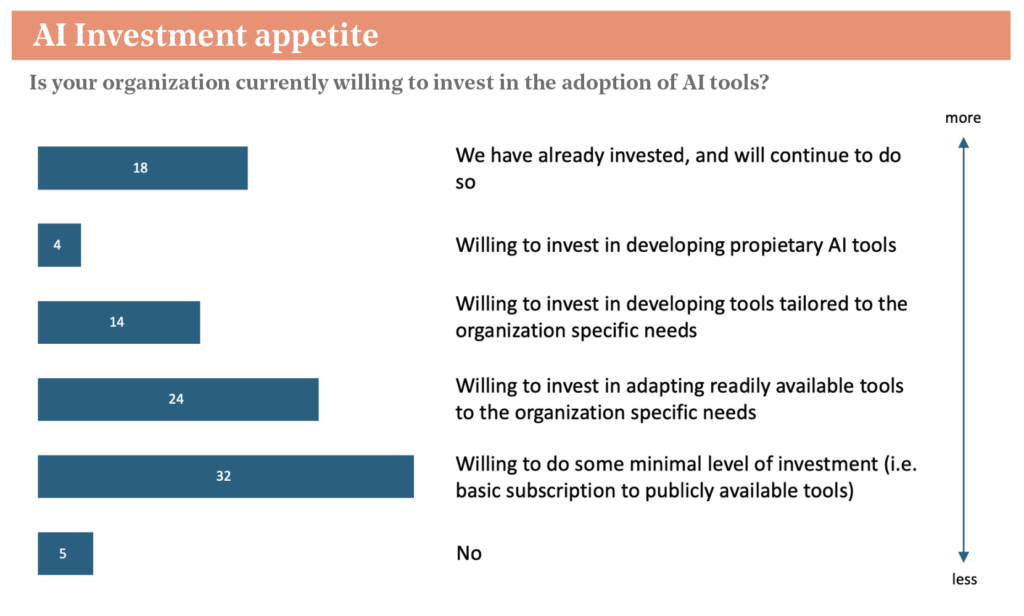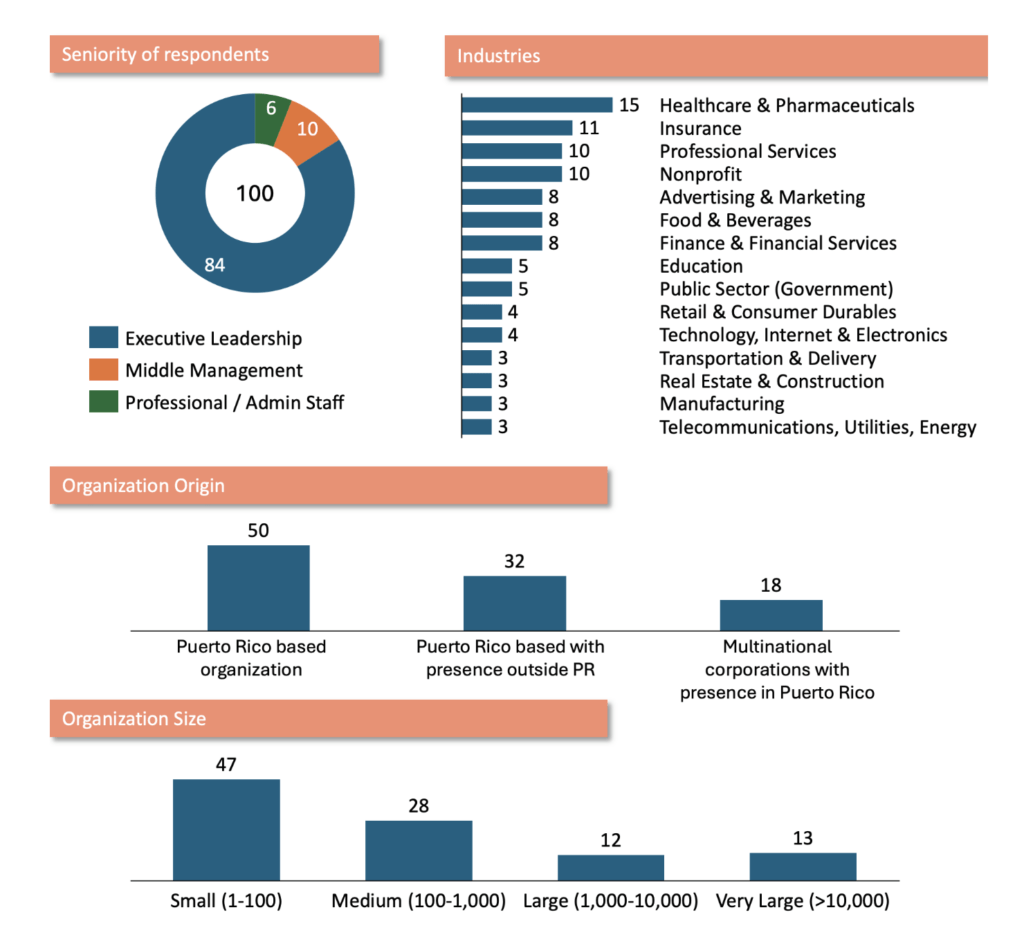100 organizations share their AI adoption status, challenges and expectations
Introduction
It seems like nothing is the same since that memorable day in November 2022 when OpenAI introduced LLMs (AI Large Language Models) to the broad audience with ChatGPT. Although Artificial Intelligence tools had been around for many years, organizations worldwide are now racing full speed ahead to understand how to leverage Artificial Intelligence tools to fulfill their missions. Organizations in Puerto Rico are no exception, but, how widespread is the use of these tools? In what ways are they being utilized? And what challenges are holding organizations back from accelerating their AI deployment?
To help answer these questions, V2A Consulting conducted a broad survey of Puerto Rican organizations to assess their adoption and use of Artificial Intelligence tools thus far. A broad cross-section of organizations, over 100 in total, responded to our survey, covering over 15 sectors of the economy and ranging in size from large multinational organizations to medium and small businesses.
What emerges from the survey, not surprisingly, is a picture of an Island in tune with the rest of the world. Local organizations are rapidly recognizing the need to understand, select, and deploy AI with promising momentum. A significant 84% of local organizations report having applied AI in at least one business function. More importantly, results suggest that AI is starting to deliver value to Puerto Rican organizations.
At the same time, there are significant variances in “depth of use” across organizations and across functional areas, as well as important challenges to deployment, with more than half of organizations reporting lack of understanding, expertise or knowledgeable resources. This is not surprising either, as it reflects what we see in our work helping clients implement AI.
"A significant 84% of local organizations report having applied AI in at least one business function. More importantly, results suggest that AI is starting to deliver value to Puerto Rican organizations."
Survey Results
AI adoption among organizations in Puerto Rico is showing promising momentum, with 84% of local organizations and 94% of multinational corporations on the Island reporting having applied AI in at least one business function.
A February 2024 report by McKinsey1 placed global AI adoption - using the same metric - at 72%. The higher adoption level observed in V2A’s survey for Puerto Rico, conducted six months later, aligns with predictions that 2024 would mark a pivotal year for the widespread adoption of AI tools.
“All areas of my organization will be impacted by AI, but for now, there is a lack of understanding on the availability of tools and the scope of work.”
- Local bank
Results highlight the growing prevalence of AI usage among respondents, with 66% regularly engaging with AI tools—whether at work, outside of work, or both. Notably, 32% report using AI in both personal and professional settings, reflecting its increasing integration into daily activities.
However, results also show a significant divide in adoption levels. 10% of respondents report no engagement with AI tools at all, and 24% have at least experimented with it, but have yet to transition into frequent usage.
For late adopters, the current landscape offers a unique opportunity to jump on the AI revolution. The availability of more user-friendly tools, increasingly refined models, and a diversified range of offerings significantly lowers the barriers to entry. Nevertheless, those who delay further will face greater challenges in catching up with a rapidly evolving AI landscape.
Marketing and Service Operations are the business functions with highest AI adoption, with over 50% of organizations already using AI tools. This reflects a focus on improving customer-facing and operational efficiency functions, where AI's benefits are increasingly evident.
In Marketing, 40% are actively considering new tools, and 11% are already developing them, likely driven by the seamless adoption of generative AI for content ideation and creation. In Service Operations, 13% of organizations have developed proprietary AI tools—the highest across functions—and 15% are currently developing them, reflecting widespread use of AI-powered chatbots.
In contrast, participants report reduced interest in adopting AI tools in Manufacturing (27%), Risk (21%) and Supply Chain management (13%), likely due to the absence of readily available or intuitive solutions for these business functions, competing technological priorities, or the perceived complexity of implementation.
These findings indicate that while some areas are making progress, AI adoption remains nascent across key business functions, leaving significant untapped potential.
“AI will have an impact across the entire organization. It will take time to identify the use cases and deploy the tools, but we’re getting there”
- Multinational bank with presence in PR
Reported main barriers to AI adoption are related to a lack of internal capabilities, with 59% citing a lack of in-house expertise and resources and 48% a lack of understanding of the technology. These challenges highlight a clear need for organizations to invest either in outsourced support, or in talent, training, and development of skills among its employees. Additionally, concerns around privacy, accuracy, and intellectual property indicate skepticism for the technology and its administrators.
Regarding investment appetite, while 37% of organizations are not ready to invest in adopting AI tools (aside from basic subscriptions to non-customizable, readily available tools), 42% are willing to invest in customized solutions (to different degrees of customization and spend), and 18% have already done so.
Wider adoption will require organizations to balance their ambitions to integrate AI tools -that they recognize can potentially unlock significant savings and growth-, with their ability to implement them, their investment capacity, and their trust on the safety of doing so. Professional services working on AI implementations that effectively address this balance will be well-positioned to succeed.
“Our whole company is going to be impacted by AI sooner or later”
- Multinational consumer goods
The survey included an open-ended question allowing organizations to share their perspectives on how and where AI will have a critical impact within their operations. Overall, participants recognized and emphasized AI’s transformative potential to drive innovation, enhance strategic initiatives, and replace routine tasks. Respondents also highlighted the importance of closing the skills gap through training, careful planning, and effective change management.
Key applications identified among the open-ended responses include streamlining administrative and operational tasks, enhancing data analytics and forecasting, improving customer experience, and supporting marketing and communication efforts. Additionally, specialized uses such as clinical workflows, legal research, and tax compliance were noted, further affirming how versatile AI is to drive innovation among all kind of industries.
Conclusion
Our survey highlights that Puerto Rico's AI adoption levels are keeping pace with global trends, showcasing the local business sector's recognition of AI's transformative potential for driving efficiency, innovation, and competitiveness. However, unique challenges persist. While global concerns often focus on data quality and privacy, Puerto Rico's main barriers are a lack of skilled professionals and limited understanding of AI technologies. Bridging this talent gap is crucial to unlocking AI’s full potential on the island.
To succeed, businesses must integrate AI into well-defined strategies aligned with their goals. Trial-and-error experimentation can be insightful but requires a disciplined approach to avoid inefficiencies. Globally, AI is reshaping industries, enhancing customer experiences, and driving operational and strategic innovations. Puerto Rico has the opportunity to adopt similar advancements but must address its distinct challenges to stay competitive.
At V2A Consulting, we support organizations in navigating these complexities by crafting tailored AI strategies, implementing actionable solutions, and fostering cultural and organizational readiness. Through robust AI technology deployment and organizational-focused Change Management initatives, we empower businesses to bridge the gap between vision and execution, ensuring continued growth and competitive advantage. Our comprehensive AI services include crafting tailored adoption strategies, designing and implementing customized solutions, and implementing readily available AI tools to meet your unique needs. Whether you're starting your AI journey or looking to enhance your existing capabilities, we provide the expertise and support needed to drive meaningful results.
Ready to take the next step in leveraging AI for your organization? Contact us today to learn more about how we can help you achieve your goals.
Appendix
Definitions of AI technologies, as portrayed in the survey.
Generative AI
AI that creates new content, such as text, images, or music based on input data. Includes tools such as ChatGPT or Claude, and any kind of tools developed to support creative content generation, personalized sales assistance, chatbots, legal documentation generation, job role description drafting, data trends analysis, content development, etc.
Natural Language Processing NLP
AI that understands, interprets and responds to human language. This includes tools that perform Call Center sentiment analysis, personalized marketing , resume screening, legal documentation analysis, text summarization, live translation services, data extraction from a text, etc.
Machine Learning ML
AI that learns from data, and makes predictions or decisions based on it, improving its performance over time without explicit programming. This includes tools developed to support demand planning, predictive customer service, dynamic pricing, text classification, personalized medicine, customer segmentation, content personalization, route optimization, etc.
Computer Vision
AI that interprets and understands visual information from images and videos. This includes tools that do document validation, inventory monitoring & management, manufacturing process quality controls, medical imaging analysis, infrastructure inspection, crop monitoring & prediction, etc.
Robotics
AI-enabled robots that perform tasks autonomously by perceiving their environment, making decisions and taking actions. This includes physical and digital robots that support document processing, web scraping, warehouse management through robotic sorting systems, precision farming, food preparation & serving, security patrolling, infrastructure maintenance, etc.
Click here to learn more.
Demographics of survey respondents
We believe the survey results provide a largely representative sample of Puerto Rico’s business community, featuring responses from both local and international organizations across fifteen industries. The participating companies range in size, from small businesses to large enterprises, based on employee count. Notably, 84% of the responses were submitted by members of the executive leadership, ensuring that the insights captured reflect a comprehensive, cross-functional perspective of each organization.
The following page presents the detailed demographic breakdowns of the survey respondents.
 Manuel A. Calderón
Manuel A. Calderón Xavier Diví
Xavier Diví
